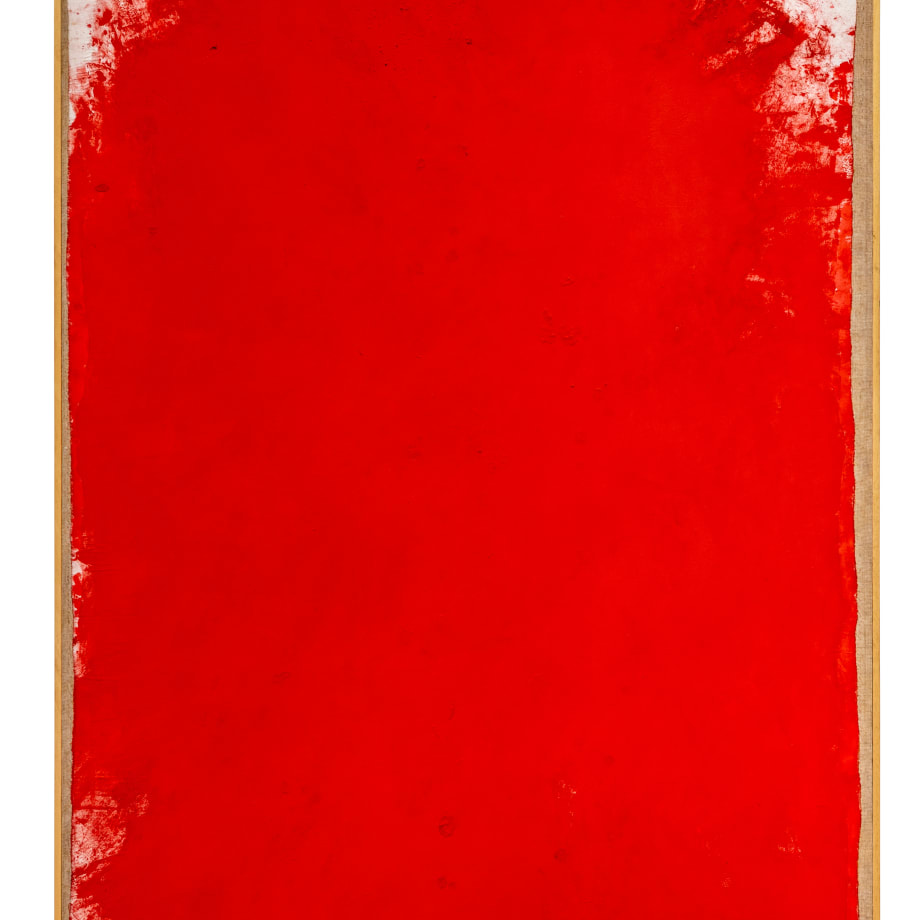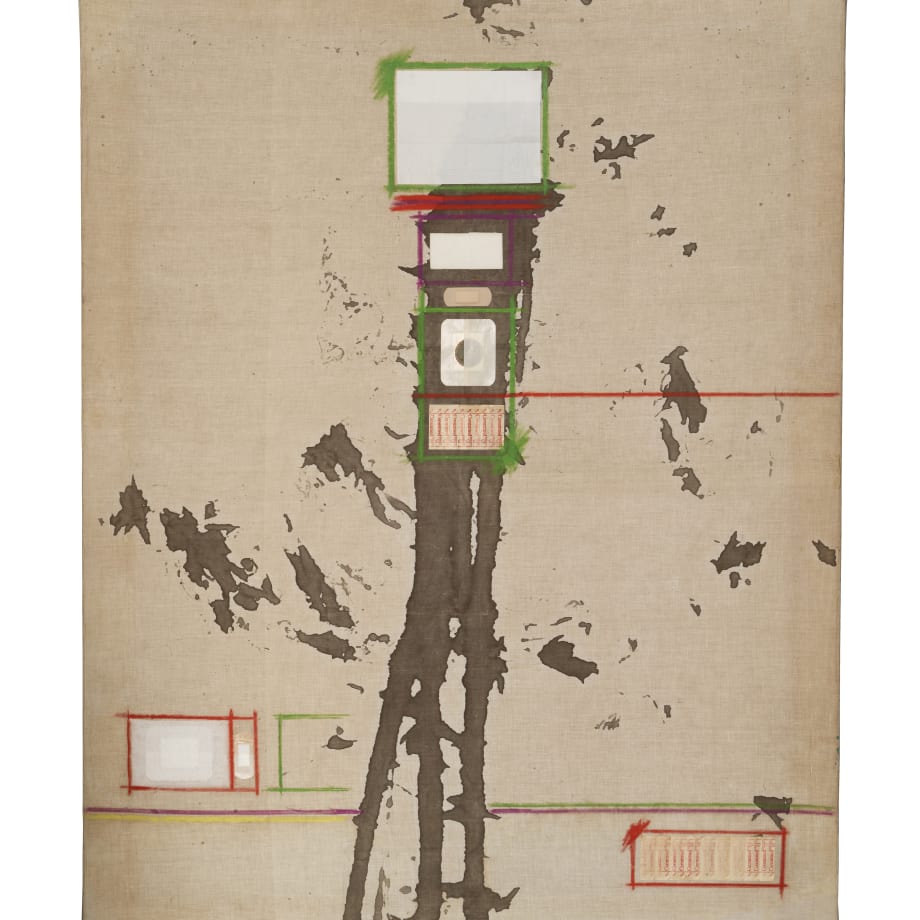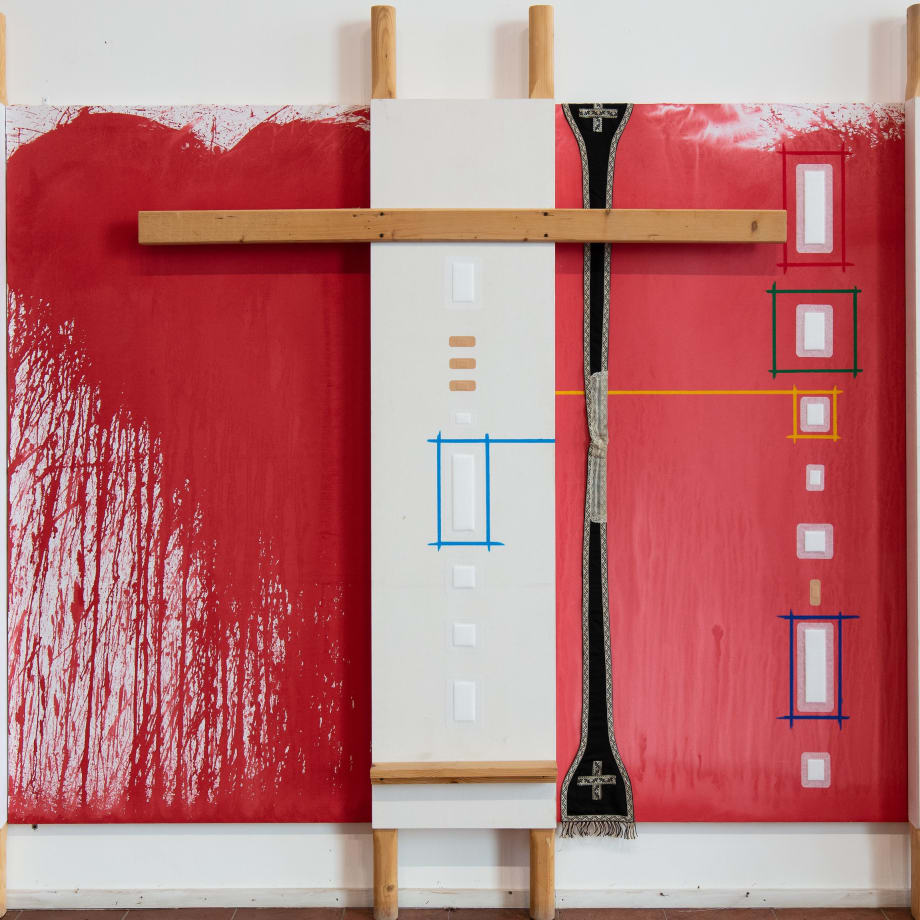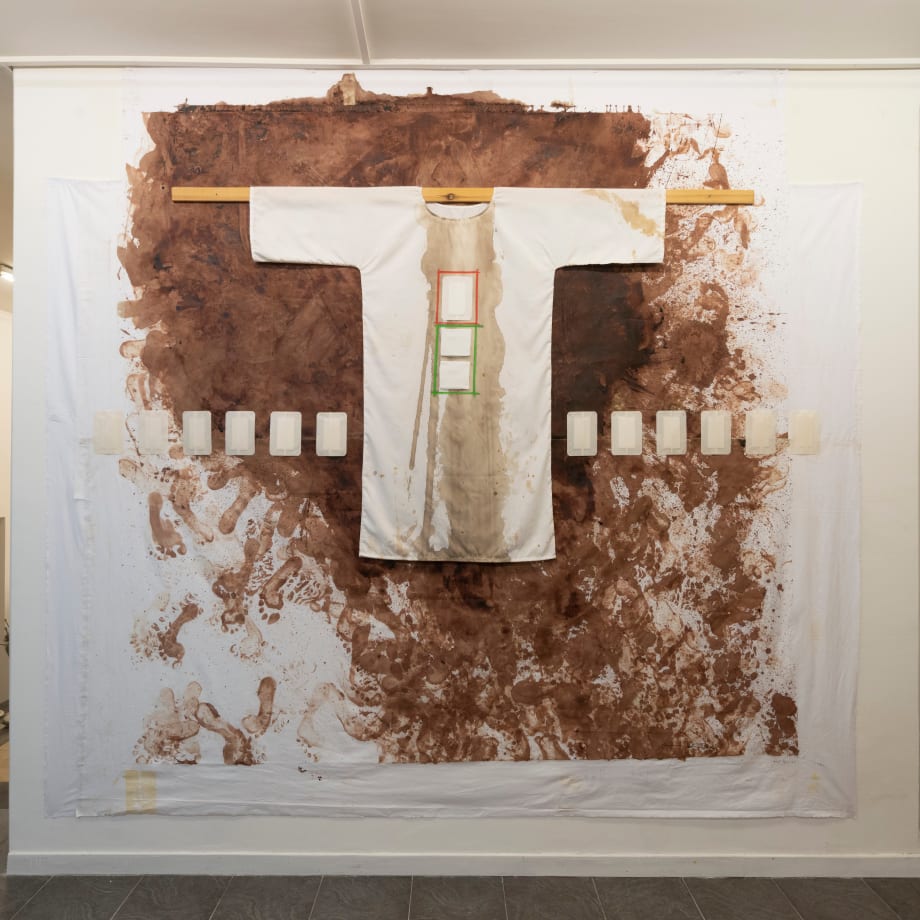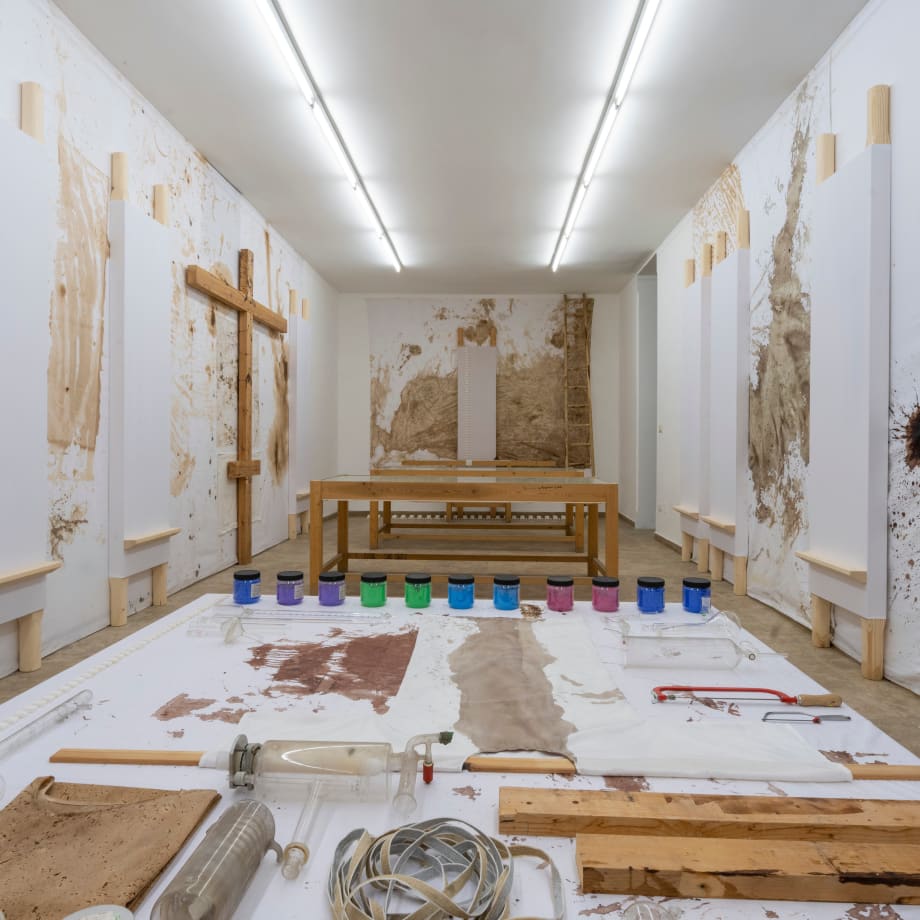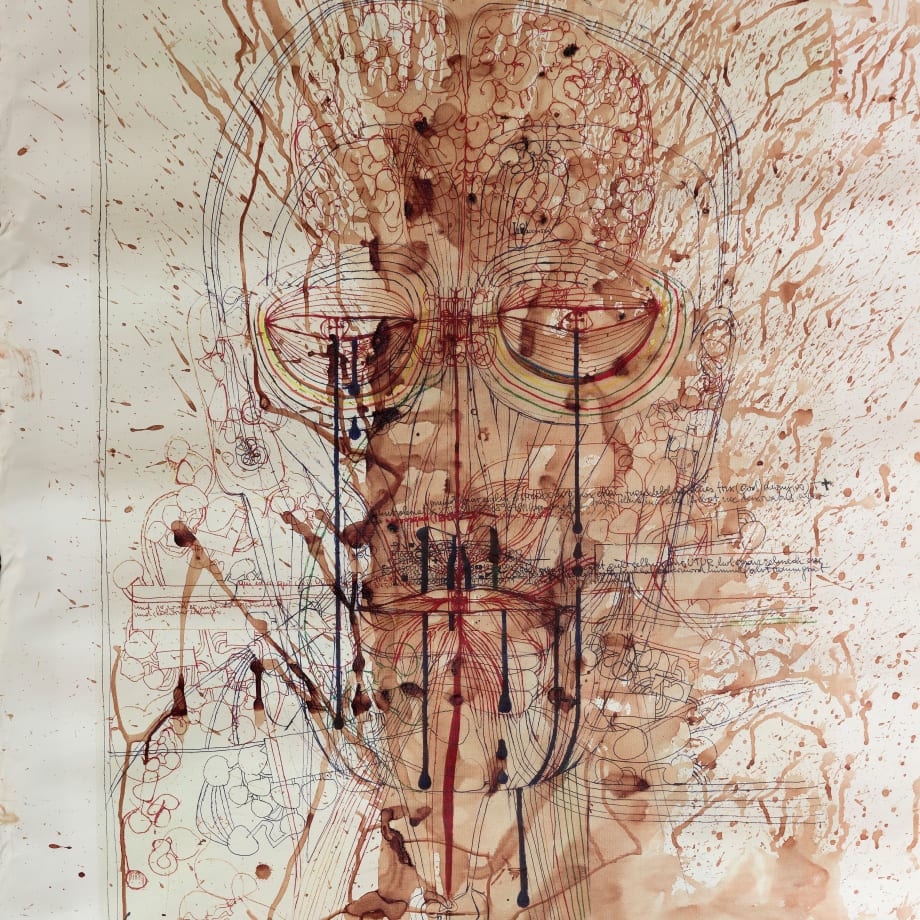HERMANN NITSCH CATHARTIC AVERSION
Paintings, Actions, Relics and Musical Scores 1962 - 2020
curated by Flaminio Gualdoni
ABC-ARTE pays tribute to a major protagonist of the contemporary scene with an in-depth and comprehensive documentary exhibition.
This exhibition of Hermann Nitsch is not a simple presentation of the inanimate remains of the actions that he triggered or accompanied, but takes on a further vitality of its own with a strong and specific degree of communicative autonomy.
The artist, performer, dramatist, musician and philosopher Hermann Nitsch, who was the main protagonist of Viennese Action Painting, is regarded by many as one of the most important Austrian artists of all time. As a particularly controversial and experimental figure at the centre of polemics and boycotts, the ‘blood artist’ experienced peaks of fame, court trials and prison sentences before confirming his role as a permanent fixture of the contemporary art panorama.
The exhibition organised by ABC-ARTE in its historic gallery in Genoa, with a soon autonomous appendix in the Milanese gallery, ABC-ARTE ONE OF, is an attempt to convey by means of dense painterly materials and spontaneous gestures the total world of experience practised by Nitsch. In 1975 he founded Das Orgien Mysterien Theater, which pervaded his entire oeuvre.
From the early eminently painterly works of the 1960s and 1970s to the large canvases with relics of 77.malaktion, 2017, the extraordinary unicum of Omaggio ad Alberto Burri [Homage to Alberto Burri], 2015, and 158.aktion, 2020, the technical aspect of the work is always ostentatiously contaminated with objects and devices, from which the ritual and liturgical aspect of the operations emerges clearly. For the gallery in Milan we have chosen to document 29.malaktion, 2018, in which the dominant yellow and the painterly component are the prevailing elements.
The experience that the artist creates, and in which he calls into question both the figures involved in the drama and the spectators, is always a process of definition of the wiseacres and a profound synaesthesia (the relation between sound and colour, material perception and vision, scents) physically experienced and savoured, capable of reactivating a level of awareness and a sensual condition that is renewed time and again. The visual documentations of the actions are themselves an essential part of the shared experience too.
The aim of the exhibition is to follow the philosophical references and intentions of this famous artist, who always emphasised how his actions, no matter how repulsive or revolting, were supposed to have a cathartic effect. The participants were drawn closer to the mysteries of life and death, often involved in crude and visceral performances, as they experienced new sensations and grew aware of the taboos imposed by social conventions.
The exhibition has been made possible thanks to the valuable collaboration of the Museo Hermann Nitsch. Archivio Laboratorio per le Arti Contemporanee [Hermann Nitsch Museum. Archive Laboratory for Contemporary Arts], founded and directed in Naples by Peppe Morra. From 1974 it has followed the work of Nitsch from all points of view and conserves materials of primary importance.
A new bilingual monograph will be published by ABC-ARTE edizioni, with texts by the curator Flaminio Gualdoni and other critics and a rich documentary apparatus, to accompany the exhibition.
Biography
Born in Vienna in 1938, Hermann Nitsch was trained in graphic advertising design and went on to work in the Technical Museum in the Austrian capital. The idea of Action Painting and Das Orgien Mysterien Theater [Theatre of Orgies and Mysteries], which became the thread running through the rest of his artistic development, came a few years later. He created the first Schüttbilder, produced by throwing paint and blood onto the canvas, a technique that was very popular with the Viennese Action Painters. Nitsch’s participation in various actions and exhibitions in Vienna led to three arrests and various court trials. Towards the mid- 1960s he and other artists such as Günter Brus, Otto Mühl and Rudolf Schwarzkogler began to form the movement that would become known as Viennese Action Painting. They also took this artistic form to various cities in Northern Europe and the United States. His brushes with the law obliged him to move to Germany in 1968, and he only returned to Austria in 1971. He settled in the castle of Prinzendorf, south of Vienna, where from then on he was to hold all his actions, particularly the performance Das Orgien Mysterien Theater. Among his most important works are 6-Tage-Spiel [6-Day Play], directed by Alfred Gulden in the summer of 1988, and his 120.azione in the form of 2-Tage-Spiel in 2004. Nitsch took part as an artist in Documenta 5 (1972) and Documenta 7 (1982) in Kassel.
Selected public collections in Italy
CIAC Centro Italiano d’Arte Contemporanea, Foligno, Italy; Castello di Rivoli, Turin, Italy; Casa Serpone, Torrita Tiberina (Rome), Italy; MAMBO Galleria d'Arte Moderna, Bologna, Italy; MART Museo di Arte Moderna e Contemporanea, Trento, Italy; Museo di Capodimonte, Naples, Italy; Pio Monte della Misericordia, Naples, Italy
Selected international public collections
AGO Art Gallery of Ontario, Toronto, Canada; Centre Georges Pompidou, Paris, France; Essl Collection of Contemporary Art, Klosterneuburg, Austria; Ferdinandeum, Innsbruck, Austria; Galerie Lenbachhaus, Munich, Germany; Guggenheim Collection, New York, USA; Kunsthalle, Hamburg, Germany; Kunstmuseum, Bern, Switzerland; Kunstmuseum Winterthur, Switzerland; Kunstsammlung Nordrhein-Westfalen, Düsseldorf, Germany; Busch-Reisinger Museum, Harvard University, Cambridge, USA; Metropolitan Museum of Art, New York, USA; MOMA Museum of Modern Art, New York, USA; Moderna Museet, Stockholm, Sweden; Mumok – Museum Moderner Kunst Stiftung Ludwig, Vienna, Austria; Museum Ludwig, Cologne, Germany; Museum, University of Yale, New Haven, USA; Nationalgalerie, Berlin, Germany; Nitsch Museum, Mistelbach, Austria; Rupertinum, Salzburg, Austria; Walker Kind Center, Minneapolis, USA; Staatsgalerie, Stuttgart, Germany; Stedelijk Museum, Amsterdam, Netherlands; Tate Gallery, London, United Kingdom; Van Abbemuseum, Eindhoven, Netherlands.
